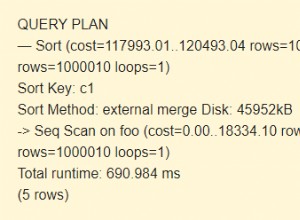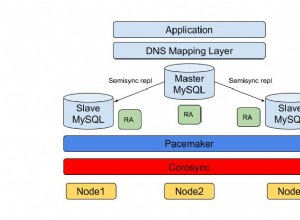C'è qualche presa? Sì, c'è:i left join sono una forma di outer join, mentre i inner join sono una forma di, beh, inner join.
Ecco degli esempi che mostrano la differenza. Inizieremo con i dati di base:
mysql> select * from j1;
+----+------------+
| id | thing |
+----+------------+
| 1 | hi |
| 2 | hello |
| 3 | guten tag |
| 4 | ciao |
| 5 | buongiorno |
+----+------------+
mysql> select * from j2;
+----+-----------+
| id | thing |
+----+-----------+
| 1 | bye |
| 3 | tschau |
| 4 | au revoir |
| 6 | so long |
| 7 | tschuessi |
+----+-----------+
E qui vedremo la differenza tra un join interno e un join sinistro:
mysql> select * from j1 inner join j2 on j1.id = j2.id;
+----+-----------+----+-----------+
| id | thing | id | thing |
+----+-----------+----+-----------+
| 1 | hi | 1 | bye |
| 3 | guten tag | 3 | tschau |
| 4 | ciao | 4 | au revoir |
+----+-----------+----+-----------+
Hmm, 3 righe.
mysql> select * from j1 left join j2 on j1.id = j2.id;
+----+------------+------+-----------+
| id | thing | id | thing |
+----+------------+------+-----------+
| 1 | hi | 1 | bye |
| 2 | hello | NULL | NULL |
| 3 | guten tag | 3 | tschau |
| 4 | ciao | 4 | au revoir |
| 5 | buongiorno | NULL | NULL |
+----+------------+------+-----------+
Wow, 5 righe! Cosa è successo?
Join esterni come left join conserva le righe che non corrispondono, quindi le righe con ID 2 e 5 vengono conservate dalla query di join sinistro. Le restanti colonne sono riempite con NULL.
In altre parole, i join sinistro e interno non sono intercambiabili.




